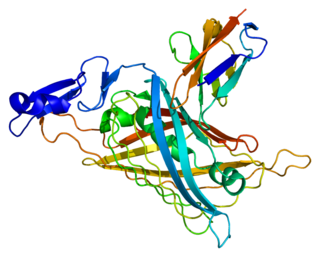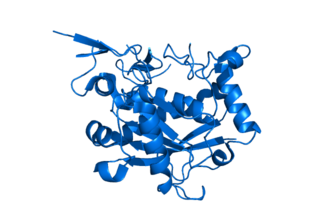Related Research Articles

Integrins are transmembrane receptors that facilitate cell-extracellular matrix (ECM) adhesion. Upon ligand binding, integrins activate signal transduction pathways that mediate cellular signals such as regulation of the cell cycle, organization of the intracellular cytoskeleton, and movement of new receptors to the cell membrane. The presence of integrins allows rapid and flexible responses to events at the cell surface.

A fibroblast is a type of biological cell that synthesizes the extracellular matrix and collagen, produces the structural framework (stroma) for animal tissues, and plays a critical role in wound healing. Fibroblasts are the most common cells of connective tissue in animals.

In biology, the extracellular matrix (ECM) is a three-dimensional network of extracellular macromolecules, such as collagen, enzymes, and glycoproteins, that provide structural and biochemical support to surrounding cells. Because multicellularity evolved independently in different multicellular lineages, the composition of ECM varies between multicellular structures; however, cell adhesion, cell-to-cell communication and differentiation are common functions of the ECM.

Thrombospondins (TSPs) are a family of secreted glycoproteins with antiangiogenic functions. Due to their dynamic role within the extracellular matrix they are considered matricellular proteins. The first member of the family, thrombospondin 1 (THBS1), was discovered in 1971 by Nancy L. Baenziger.

Perlecan (PLC) also known as basement membrane-specific heparan sulfate proteoglycan core protein (HSPG) or heparan sulfate proteoglycan 2 (HSPG2), is a protein that in humans is encoded by the HSPG2 gene.

Thrombospondin 1, abbreviated as THBS1, is a protein that in humans is encoded by the THBS1 gene.

CTGF, also known as CCN2 or connective tissue growth factor, is a matricellular protein of the CCN family of extracellular matrix-associated heparin-binding proteins. CTGF has important roles in many biological processes, including cell adhesion, migration, proliferation, angiogenesis, skeletal development, and tissue wound repair, and is critically involved in fibrotic disease and several forms of cancers.

72 kDa type IV collagenase also known as matrix metalloproteinase-2 (MMP-2) and gelatinase A is an enzyme that in humans is encoded by the MMP2 gene. The MMP2 gene is located on chromosome 16 at position 12.2.

Cysteine-rich angiogenic inducer 61 (CYR61) or CCN family member 1 (CCN1), is a matricellular protein that in humans is encoded by the CYR61 gene.

NOV also known as CCN3 is a matricellular protein that in humans is encoded by the NOV gene.

A disintegrin and metalloproteinase with thrombospondin motifs 1 is an enzyme that in humans is encoded by the ADAMTS1 gene.

Thrombospondin-2 is a protein that in humans is encoded by the THBS2 gene.

WNT1-inducible-signaling pathway protein 1 (WISP-1), also known as CCN4, is a matricellular protein that in humans is encoded by the WISP1 gene.

WNT1-inducible-signaling pathway protein 3 is a matricellular protein that in humans is encoded by the WISP3 gene.

WNT1-inducible-signaling pathway protein 2, or WISP-2 is a matricellular protein that in humans is encoded by the WISP2 gene.

Thrombospondin-4 is a protein that in humans is encoded by the THBS4 gene.

SPARC-like protein 1, also known as hevin, is a secreted protein with high structural similarity to SPARC. It interacts with the extracellular matrix to create intermediate states of cell adhesion. Due to its dynamic extracellular roles, being implicated in cancer metastasis and inflammation, it is considered a matricellular protein. In humans hevin is encoded by the SPARCL1 gene.
Transforming growth factor beta (TGF-β) is a potent cell regulatory polypeptide homodimer of 25kD. It is a multifunctional signaling molecule with more than 40 related family members. TGF-β plays a role in a wide array of cellular processes including early embryonic development, cell growth, differentiation, motility, and apoptosis.
Von Willebrand factor, type C is a protein domain is found in various blood plasma proteins: complement factors B, C2, CR3 and CR4; the integrins (I-domains); collagen types VI, VII, XII and XIV; and other extracellular proteins.
CCN proteins are a family of extracellular matrix (ECM)-associated proteins involved in intercellular signaling. Due to their dynamic role within the ECM they are considered matricellular proteins.
References
- ↑ Bornstein P (August 1995). "Diversity of function is inherent in matricellular proteins: an appraisal of thrombospondin 1". J. Cell Biol. 130 (3): 503–6. doi:10.1083/jcb.130.3.503. PMC 2120533 . PMID 7542656.
- ↑ Bornstein P, Sage EH (October 2002). "Matricellular proteins: extracellular modulators of cell function". Curr. Opin. Cell Biol. 14 (5): 608–16. doi:10.1016/S0955-0674(02)00361-7. PMID 12231357.
- ↑ Roberts DD, Lau LF (2011). "Chapter 11: Matricellular Proteins". In Mecham RP (ed.). The Extracellular Matrix: an Overview (Biology of Extracellular Matrix). Berlin: Springer. ISBN 978-3-642-16554-2.
- ↑ Roberts DD (October 2011). "Emerging functions of matricellular proteins". Cell. Mol. Life Sci. 68 (19): 3133–6. doi:10.1007/s00018-011-0779-2. PMC 3556643 . PMID 21833584.
- ↑ Jun JI, Lau LF (December 2011). "Taking aim at the extracellular matrix: CCN proteins as emerging therapeutic targets". Nat Rev Drug Discov. 10 (12): 945–63. doi:10.1038/nrd3599. PMC 3663145 . PMID 22129992.
| This protein-related article is a stub. You can help Wikipedia by expanding it. |